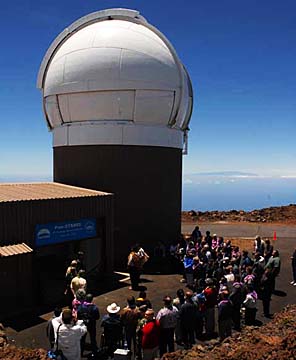
COURTESY PHOTO
A dedication and blessing ceremony for the Pan-STARRS 1 prototype telescope was held on the summit of Haleakala, Maui, on June 30.
|
|
Maui telescope draws star partners
A prestigious team signs on to run the prototype surveyor
Some of the world's top astronomers will work with UH astronomers to analyze an unprecedented flood of data expected from the Pan-STARRS telescope atop Haleakala.
The new partners will provide $10 million to operate the PS1 prototype of the Panoramic Survey Telescope and Rapid Response on Maui, said Kenneth Chambers,* an astronomer with the University of Hawaii Institute for Astronomy.
"The sky is a dynamic thing. The universe is full of things that go bump in the night. There are solar system objects that move. There are stars that blow up. There are black holes that form, and in collapsing stages produce extraordinarily bright transient phenomena," he said.
A prime objective of the prototype telescope is to track potentially dangerous near-Earth asteroids, but it also will survey other moving objects in space, said Chambers, project scientist for the PS1 survey.
"The same data is useful from inside the orbit of the moon to the edge of the universe, and every astronomer in every field of astronomy will be able to use that data to address critical issues in their own field of astronomy," he said.
The telescope is the forerunner for an array of four telescopes planned in the $50 million Pan-STARRS system.
UH astronomer Nicholas Kaiser is principal investigator of Pan-STARRS. Site studies are under way to determine whether Haleakala or Mauna Kea is the best place for the array, and full environmental impact studies will be done.
IFA Director Rolf Kudritzki announced in a news release formation of a "powerful consortium" of prestigious institutions to use data from PS1. It includes the Max Planck Society in Germany, Harvard University, Johns Hopkins University and the Las Cumbres Observatory in the United States, and Durham, Edinburgh and Belfast universities in the United Kingdom.
More than 30 scientists and their graduate students will analyze the PS1 data over the next 3 1/2 years.
The telescope, with a 71-inch-diameter mirror, achieved "first light" in June and is undergoing engineering tests. It will be fully operational next year.
UH astronomer John Tonry is leading development of the world's largest digital camera for the PS1 telescope at the institute headquarters in Manoa. It will have a resolution about 300 times that of a typical commercial digital camera. It will see deeper into the universe and survey the sky repeatedly, Chambers said.
"By surveying the sky over and over and over again, we get not just a map of the universe, but a movie of the changing universe."
He said mapping of the solar system as it is today "provides a fossil record" of the formation of the solar system and will provide insight into its origin.
"The crucial part of this is when something out of the universe does go bump in the night, we want to follow that up with other telescopes," Chambers said. "It will increase the productivity of every other telescope on Earth and in space."
CORRECTION
Wednesday, October 11, 2006
» Kenneth Chambers, astronomer with the University of Hawaii Institute for Astronomy, is project scientist for PS1, the Panoramic Survey Telescope and Rapid Response prototype on Haleakala, Maui. His first name was incorrect in a Page A17 story Sunday.
|

